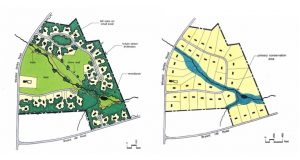It’s nice to know that stone walls are increasingly being retained within subdivision designs, rather than obliterated as being in the way. In this quick post, I relay (with permission) a particularly eloquent paragraph by Randall Arendt, from a chapter titled “Protecting Natural and Historic Resources through Conservation Design” within his 2009 book Envisioning Better Communities. I have boldfaced words and phrases that are particularly critical to the mission of the Stone Wall Initiative.
A wide variety of site features involve historical uses, including farmhouses, barns, country lanes, stone walls, wells, cellarholes, hedgerows, etc. Incorporating them into site design can add significant interest value to the neighborhood, improving marketing possibilities and enhancing the quality of life of residents in the development and the surrounding community. From long experience, I can say that designing around stone walls and hedgerows (or fencerows) is not difficult to do when one is given flexibility in lot size, lot width, and street geometry. All too often these features are blithely ignored by site planners who either have not walked the property to locate them, or who demonstrate no care or reverence for these artifacts from earlier eras. (Quoting Daniel Webster: “The man who feels no sentiment or veneration for the memory of his forefathers is himself unworthy of kindred regard or remembrance.”) To the extent that these value-adding aspects of the property are not retained, when it is relatively easy to do so, site designers are not serving either their clients or the community very well…
The pair of his drawings above show: to the left, a subdivision layout conserving and highlighting the historic features; and to the right, a traditional layout where lot size is maximized at the expense of the historic landscape. Which would you rather live in?
For more information, visit Arendt’s website Greener Prospects.
